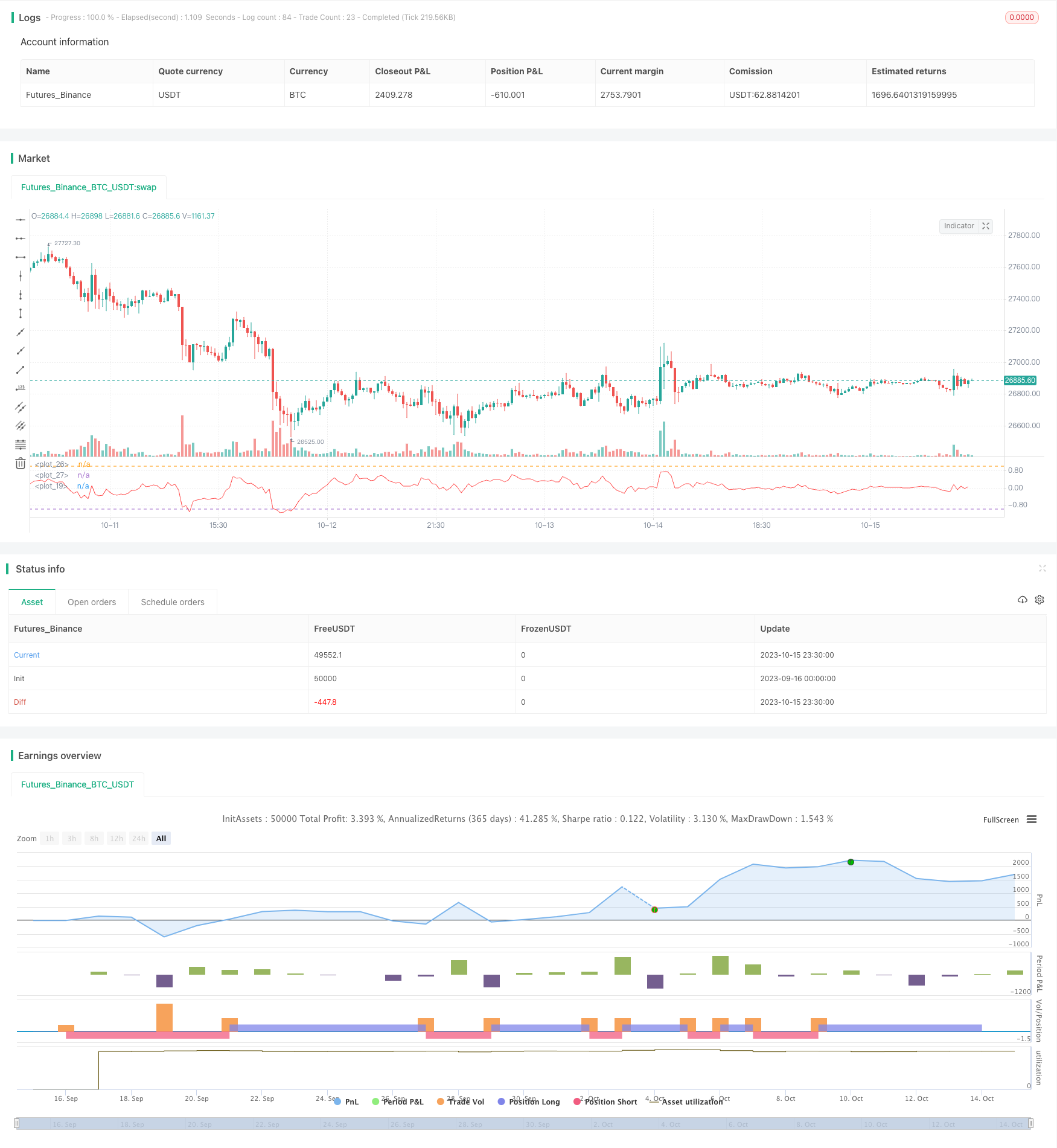
概述
DEMA趋势追踪策略基于DEMA指标设计,当价格突破DEMA指标下轨时产生买入信号,当价格跌破DEMA指标上轨时产生卖出信号,属于趋势跟踪策略。
策略原理
该策略使用DEMA指标判断价格趋势。DEMA指标是双指数移动平均线,它使用两个EMA线计算得到,可以更快捕捉价格变化。策略通过计算价格与DEMA的差值百分比,然后给出买入和卖出信号。
当差值百分比上穿设定的参数buyper时,产生买入信号。当差值百分比下穿设定的参数sellper时,产生卖出信号。buyper和sellper参数代表产生信号的strength,可以根据市场调整。
此外,策略还设置了年月日范围作为过滤条件,只有在指定的日期内才会产生交易信号。
策略优势分析
- 使用DEMA指标可以更敏感地捕捉价格变化,及时捕捉趋势反转。
- 相比SMA指标,DEMA指标有更低的滞后性。
- 设置买卖strength参数,可以控制交易频率。
- 添加日期过滤条件,可以针对季节性行情进行优化。
- 整体来说,该策略parametrs设置合理,可以进行参数优化,从而适应不同市场环境。
策略风险分析
- DEMA指标本身存在滞后性,可能错过短期趋势反转。
- 信号产生有一定滞后,入场时点不精确。
- 策略仅基于DEMA指标,没有辅助指标验证信号可靠性。
- 没有设置止损,可能给账户带来较大亏损。
可以通过结合其他指标验证信号,优化参数设置,添加止损来控制风险。
策略优化方向
- 可以考虑加入MA指标进行信号过滤,利用MA的顺势性特点验证趋势。
- 可以测试不同参数对策略收益率的影响,找到最优参数组合。
- 可以添加止损策略,设置合理的止损幅度,控制单笔亏损。
- 可以测试不同股票对策略效果的影响,优化股票池。
- 可以尝试多种exit策略,如趋势反转,突破等退出机制。
总结
DEMA趋势追踪策略整体设计合理,具有一定的稳定盈利能力。该策略成功运用DEMA指标判断趋势方向,可以对多种股票和大中长线周期有效。通过参数优化、辅助指标验证、止损策略等手段可以进一步提高策略收益率并控制风险。该策略有一定的实盘运用价值,但需要根据不同市场环境不断测试和优化,才能获得长期稳定收益。
策略源码
/*backtest
start: 2023-09-16 00:00:00
end: 2023-10-16 00:00:00
period: 30m
basePeriod: 15m
exchanges: [{"eid":"Futures_Binance","currency":"BTC_USDT"}]
*/
//@version= 2
strategy("DEMA PRICE DİFFERENCE Strategy ",shorttitle="DPD% STR " ,overlay=false)
buyper =input(-1)
sellper=input(1)
demalen = input(50,title="Dema Length")
e1= ema(close,demalen)
e2=ema(e1,demalen)
demaprice = 2 * e1 - e2
price=close
demadifper = ((price-demaprice)/price)*100
plot(demadifper, color=red)
OverDemaPer = input(1, title="Band for OverBought")
UnderDemaPer= input(-1,title="Band for OverSold")
band1 = hline(OverDemaPer)
band0 = hline(UnderDemaPer)
zeroline=0
fill(band1, band0, color=green, transp=90)
yearfrom = input(2018)
yearuntil =input(2019)
monthfrom =input(6)
monthuntil =input(12)
dayfrom=input(1)
dayuntil=input(31)
if ( crossover(demadifper,buyper))
strategy.entry("BUY", strategy.long, stop=close, oca_name="TREND", comment="BUY")
else
strategy.cancel(id="BUY")
if ( crossunder(demadifper,sellper) )
strategy.entry("SELL", strategy.short,stop=close, oca_name="TREND", comment="SELL")
else
strategy.cancel(id="SELL")